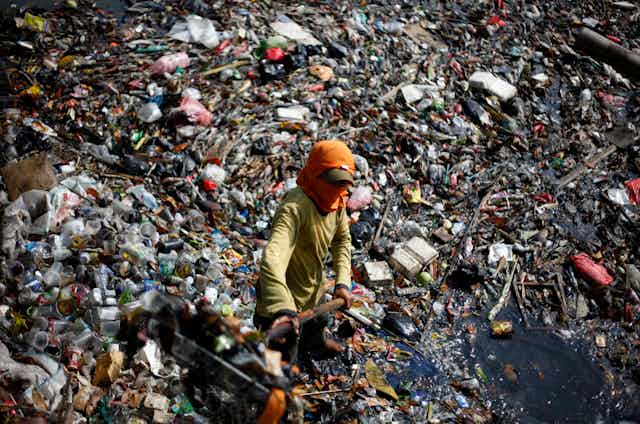This article is to mark Indonesia’s National Waste Awareness Day (Hari Peduli Sampah Nasional) on February 21.
Dubbed the world’s second-largest marine polluter, Indonesia has ambitious targets to reduce plastic waste by 70% by 2025.
However, the government may have to recalculate that target and its approach. Our research in 2018 indicates that Ciliwung river, which divides Indonesia’s capital Jakarta, is among the most polluted rivers in the world.
Involving a group of Indonesian scientists from local NGO Waste4Change and Dutch researchers, our study found samples from Ciliwung river are more polluted than at least 20 rivers in Europe and Southeast Asia.
We monitored levels of macro plastics (plastics with a size of more than five milimetres) in five locations of Ciliwung river in May 2018. We found 20,000 items flowing into the ocean per hour.
That figure is way higher than for the Chao Phraya river in Thailand (5,000 items per hour), Seine river in France (700 items) and Rhine river in the Netherlands (80 items).
The study also finds the weight of plastic waste from all rivers in Jakarta totals 2.1 million kilograms, equivalent to 1,000 Tesla Model S cars.

Other interesting findings
In the five locations we surveyed, we mostly found plastic bags and food wrappings. This suggests people directly dumped their household wastes into the water system.

Another finding was that the amount of plastic waste was higher when there were more water flows.
This is important to understand as it suggests most of the plastic waste is transported during the rainy season, the peak of river flows.
If the city really wants to reduce its contribution to global plastic pollution, then we need to be prepared to reduce plastic pollution during its peaks in rainy seasons.
Next moves
In terms of science, I suggest other cities and countries, including Indonesia, should consider conducting plastic waste monitoring in their rivers and waterways as well.
Though a relatively new science, the study of plastic pollution in rivers and canals, known as riverine plastic pollution, holds the key to reducing the amount of plastic waste entering the oceans.
It is necessary to establish benchmark values for plastic pollution in rivers around the world.
This will help governments set priorities for what rivers should be cleaned first. The benchmark will also help ensure the efficacy of technological solutions.
Read more: Indonesia needs more research on how plastic waste in the ocean impact marine life. Here's why
Wageningen University and Research in the Netherlands are collaborating with top Indonesian universities and researchers – Bandung Institute of Technology (ITB), Sepuluh Nopember Institute of Technology (ITS), IPB University, the Indonesian Institute of Sciences and the Ministry of Maritime Affairs and Fisheries – to study the 20 most polluted rivers in Java, Indonesia’s most populated island, and provide data-driven suggestions to tackle plastic waste in Indonesia.
Knowing where these plastics come from, how they flow through the water system and how they vary during the year is essential for all stakeholders to prevent more waste flowing into the oceans.


